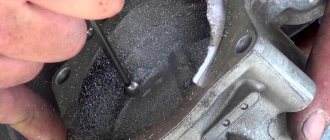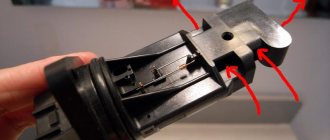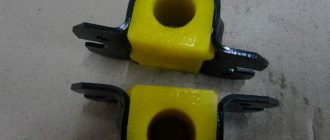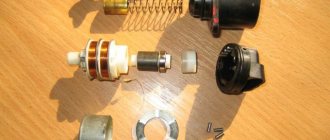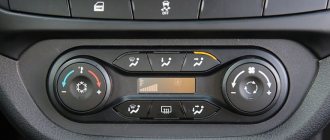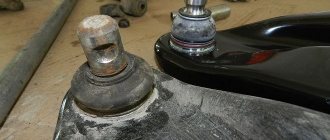23.10.2019
| (Votes: 3, Rating: 4.33) |
Issues discussed in the material:
- What is a throttle valve and how does it work?
- What are the causes and symptoms of a clogged throttle body?
- How to clean the throttle valve yourself
- How to “train” the throttle valve after cleaning
The throttle valve is one of the most important elements of a car. Although its size is small, its role - regulating the flow of air into the intake manifold - is of paramount importance. Long-term operation of a vehicle in Russian climatic conditions significantly increases the risk of damage to this element. Regular cleaning of the throttle valve from carbon deposits and other contaminants will help minimize unpleasant consequences. Otherwise, you need to be prepared for loss of engine power, ignition problems and other troubles.
What is a throttle valve and how does it work?
The throttle valve, located between the intake manifold and the air filter, is one of the most important elements of a car's engine intake system. Despite the lack of need for this part for diesel cars, it is installed on them in case of engine malfunctions. Gasoline engines equipped with a valve lift control system also do not require a throttle valve, however, most often it is installed.
The task of this element is to supply and regulate the air flow that forms the air-fuel mixture. That is, the correct functioning of the valve affects how stable the engine will operate, how fuel will be consumed and how the car will function as a whole.
The throttle valve is essentially a bypass valve. When it is open, pressure equal to atmospheric pressure is maintained in the intake system. When the plug is closed, the pressure drops, approaching the vacuum value (since the engine functions as a pump). This is the reason for the connection between the brake booster and the intake manifold. Structurally, the damper is a round plate that rotates 90°. During one revolution, a cycle occurs from full opening to full closing of the valve.
The throttle valve block (module) consists of the following elements:
- Housings with pipes that are connected to ventilation systems, collecting fuel vapors and coolant (used to heat the element).
- An actuator that, when the gas pedal is pressed, moves the valve.
- Position sensors (potentiometers) that measure the valve opening angle and transmit a signal to the engine control unit. Modern systems are equipped with two sensors that monitor the position of the throttle valve. They can have sliding contact (potentiometers) or be magnetoresistive (non-contact).
- An idle speed regulator that maintains the required crankshaft speed when the element is closed. It provides a minimum throttle opening angle when the gas pedal is released.
Cleaning rules
Despite the fact that the throttle valve is a simple mechanism in design, its maintenance should be carried out carefully and certain rules should be followed:
- If you decide to carry out cleaning, then in order to carry out the work efficiently, you need to remove the throttle assembly in order to thoroughly wash it from all sides;
- Before starting work, you should make sure that the part really requires cleaning (there is no need to remove it again);
- Removal of deposits should only be carried out using special cleaning agents followed by wiping with a soft cloth. For cleaning, do not use brushes, hard materials, or wire (for cleaning thin channels);
- On some cars with an electromechanical damper, after work, you need to configure the drive control system (the so-called “learning” of the damper) so that the ECU controls the unit correctly.
Compliance with all these rules will allow you to clean the throttle valve yourself correctly and without damage, without resorting to the services of car services.
Types of throttle valves
Three types of throttle valves are produced. They can have a mechanical drive, be electromechanical and electronic. They were created and developed in the above order. Each variety has its own design features. As it improved, the knot became simpler rather than more complex, but certain nuances appeared.
- Mechanical damper.
As soon as the fuel injection system appeared on cars, they began to be equipped with mechanically driven throttle valves. The unit differs in that the driver needs to control it independently. For this, a cable drive is used, which connects the gas pedal to the gas sector aligned with the valve axis.Structurally, the unit is similar to the carburetor system, the only difference is that the damper is a separate element. The unit is supplemented with a position sensor (determining the opening angle of the valve), an idle speed regulator, bypass channels, and a heating system. The valve position sensor is an element of all types of units. It determines the opening angle, thanks to which the electronic injector control unit understands how much air should be supplied to the combustion chambers and adjusts the flow of fuel.
The system was originally equipped with a potentiometric sensor, which used a change in resistance to measure the opening angle. Currently, more reliable magnetoresistive sensors are used. The reliability of this type of device is explained by the absence of contact pairs, which wear out over time.
Mechanical throttles are equipped with idle speed regulators, which are separate channels that bypass the main one. Adjustment of the air supply, depending on the operating conditions of the power unit, is carried out by an electric valve. It functions as follows - at idle the throttle is closed, but since the engine cannot operate without air, it enters through a separate channel. The task of the control unit is to determine the crankshaft speed, which allows you to adjust the degree of opening of the channel solenoid valve that maintains the required speed.
The principle of operation of bypass channels is similar to the principle of operation of the regulator. However, they serve to maintain engine speed in the event of a load at idle. For example, if you turn on the climate system, the engine is subjected to increased load, which leads to a drop in speed. If the regulator is unable to provide the power plant with the required amount of air, the bypass channels are used. They have a significant drawback - due to their small cross-section, there is a high probability of clogging and icing. To avoid the latter, the throttle valve is connected to the cooling system. Cooling liquid passes through the channels located inside the housing, the task of which is to warm them up.
The disadvantage of the mechanical unit is the existing error allowed in the process of preparing the air-fuel mixture, which affects the engine efficiency and final power. This occurs because the control unit does not control the damper, but only receives information regarding its opening angle. In this regard, if the throttle position was suddenly changed, the ECU may not have time to orient itself to the changed conditions and lead to increased fuel consumption.
- Electromechanical throttle valve.
With the development of technology, the mechanical damper was replaced by an electromechanical one. It was still controlled by a cable. However, its design did not provide for additional channels. But the unit was supplemented with an electronic mechanism for partial control of the valve, the operation of which was regulated by the control unit.The design of the unit consists of an electric motor with a gearbox connected to the damper axis. The operation of the unit is carried out as follows: after the engine is started, the control unit calculates the required amount of air, and the damper opens to a certain angle. Such a control unit can regulate the operation of the power unit at idle. Other engine operating modes still require driver control of the valve.
We recommend
“Throttle sensor malfunctions: we understand the device and diagnostic methods” More details
Thanks to the partial control mechanism, the design of the unit has been simplified, but the main drawback - the error in mixture formation - remains. It is only absent when the engine is idling. - Electronic damper.
Modern cars are increasingly equipped with electronic throttle valves. In them, the gas pedal and the damper axis do not directly interact with each other. The valve is controlled automatically. The design also consists of an electric motor with a gearbox, which is connected to an electronically controlled axis. However, the ECU controls the throttle in all engine operating modes. The unit is supplemented with a gas pedal position sensor.During operation, the ECU uses data transmitted by throttle position sensors, gas pedal, automatic transmission, brake and climate control systems, and cruise control.
The valve opening angle is set based on received and processed information. The intake system is completely under the control of the ECU. Thus, the problem with the error in mixture formation has been solved. The required amount of air will flow regardless of the engine operating mode.
However, such a system also has certain disadvantages, and even more so than the previous two. First, an electric motor is used to open the valve. If a drive malfunction occurs, the unit begins to operate incorrectly, which leads to deficiencies in the functioning of the power unit.
Secondly, insufficiently developed software leads to delays in throttle operation (this point is especially relevant for budget cars). The disadvantage is that after the gas pedal is pressed, the ECU does not collect and process information immediately, but after some time, and only then signals the electric motor that controls the throttle. Usually this is not noticeable, but in some cases it can cause negative consequences.
For example, when starting to move on a slippery surface, it is necessary to quickly switch the engine operating mode, which means it is important that the engine responds to the driver’s actions as quickly as possible. However, due to the delayed reaction, driving the car becomes more difficult, since the driver cannot “feel” the power unit.
Some car owners note another drawback of the electronic damper, which lies in certain factory settings for the operation of the unit. The ECU prevents wheel slipping when starting to move, which in some cases has a negative value.
Premium cars have normal software installed that eliminates response delays. In addition, it is possible to change the engine operating mode depending on preferences. For example, when the “sport” mode is turned on, it reconfigures the functioning of the intake system; when starting to move, the ECU does not affect the power plant, so you can quickly move off.
Opinions of car enthusiasts about the malfunction of the damper sensor
Coolant temperature indicator sensor VAZ 2108, 2109, 21099
1. PDZ sensor - works the same as the simplest volume controls in older TV models...
“This device is an analogue of the simplest volume control that is found in old televisions. The sensor has the following problems - “rustling” during operation. If in the case of a TV the regulator is not used so often, then in a car the throttle sensor works constantly. Its “rustling” is far from the speed that can be expected in accordance with the logic of movement. This is precisely what causes difficulties with engine speed freezing by 1.5-2 thousand revolutions or more. It is worth noting that the ECU will definitely detect a malfunction of the throttle sensor, as a result of which a “check” will light up on the dashboard. Usually the code for such an error is deciphered as “High level of TPS”.
2. Lean mixture is a consequence of problems with the throttle sensor
“If I understand correctly, when driving at a constant speed the car jerks, and when the accelerator is abruptly released, a dip is felt and the engine may stall. If the throttle is more than half open, does the car drive pretty well?
If all the symptoms converge, then:
- Was the mixture composition measured at a car service?
- the symptoms indicate a possible lean mixture, so I would first check the lambda probe and then the air flow sensor. Of course, you should also check all sorts of places where excess air is leaking, but not the throttle sensor.
- disconnect the lambda probe and drive without it; if the car drives normally at average values, then you need to change the lambda.
This is what my opinion looks like at this moment. If it’s wrong, we’ll think further.”
3. Why does the engine stall?
“The car may stall due to a faulty throttle sensor. When my car's engine stalled, I adjusted the TPS and the stalling disappeared!!! This measure was enough for about 5-7 km (I tested the engine in different modes, turning it off and starting it up, but it ran smoothly), but the car suddenly “started up” and no other throttle sensor settings helped. At the same time, at the service station they told me that the reason for the unstable operation of the motor was not the remote control sensor. I just don't believe them! At first they claimed that the thermostat was “to blame,” but not the one that controls the cooling of the engine, but the one located near the throttle valve (I didn’t even know about that). There is an antifreeze stain in this area, and the mechanics decided that the problem was caused by this thermostat. Then they thought some more and switched to the valve in the motor, then to the wiring, etc.
After an unsuccessful search, the service station called me, apologized and said that they did not know what the reason was. I note that the composition of the drops on the thermostat is not similar to coolant, but to ordinary water. I removed the sensor - it was dry inside, which means no water got in there, but the drops were right on the throttle sensor chip! When I started to blow through the TPS, small splashes flew out of it.”
4. Incorrect sensor settings
“Due to errors in setting the throttle sensor, the wrong signal is sent to the ECU. Incorrect information about the throttle opening level is supplied, which means the dosage of the fuel mixture is disrupted. Of course, the lambda probe can adjust the mixture. I would correct the settings myself. I understand that this is simple and short-lived, but “there is nothing more permanent than temporary.”
Causes and symptoms of throttle valve contamination
Over time, the throttle valve becomes dirty, and it is impossible to prevent this process. The reasons for the appearance of carbon deposits on its walls and on the assembly itself are:
- Oil sedimentation with inclusions of combustion product particles entering the throttle due to crankcase ventilation, which reduces the toxicity of exhaust gases.
- Poor performance of the air filter. If the filter cannot cope with dust, it settles on a layer of oil with combustion products.
A large amount of deposits prevents the throttle valve from functioning normally. Due to dirt, turbulence occurs when air is supplied, reducing its volume, which is assumed by the ECU. In addition, deposits prevent the damper from closing completely, allowing excess air inside.
The symptoms of throttle malfunctions have common symptoms, but problems are not always caused by carbon deposits on the unit. The issue could be the throttle sensor, drive failures, etc. Among the main signs of contamination of the unit are:
- Interruptions in engine operation at idle (stalls, speed is unstable).
- If the speed does not exceed 20 km/h, when you press the gas, the car begins to twitch.
- The engine is difficult to start.
When checking the throttle, it is necessary to evaluate the condition of the valve, even if it is not the cause of the malfunction. It is better to clean the throttle valve in advance, then you will not have to worry about deposits that negatively affect the operation of the engine.
Types of throttle units VAZ 2114
Radiator fan switching diagram for VAZ 2108, 2109, 21099
A mixture of air and gasoline enters the combustion chamber. In order for fuel combustion to occur as required, it is necessary that gasoline and air be in a strictly defined proportion. The throttle valve helps regulate the amount of air that enters for combustion.
It may become dirty during operation. If it is not cleaned, this will lead to problems when starting the engine or to a decrease in engine power. Problems may arise due to polluted air or oil contamination.
In the first case, control occurs using a mechanical cable. It is connected to the gas pedal. The driver adjusts the throttle by pressing this pedal. In this case, the cable is tensioned, displacing the semicircular part located on the same axis of rotation with the damper.
Mechanical throttle
As a result of changing the throttle position, the opening increases or decreases, affecting the amount of air entering the combustion chamber. This type of throttle control is typical for relatively inexpensive cars.
Electronic throttle
Modern car models use electronic control. The driver uses an electronic gas pedal. When you press or release the pedal, the corresponding signal is sent to the electronic control unit. The throttle control module then receives a command that causes the part to behave in the desired manner.
The damper can also change its location in the following cases:
- During mixture injection or ignition.
- If the required motor speed has been reached.
- When the car starts moving.
- When accelerating.
The throttle valve on the VAZ 2114 with an electronic gas pedal is more convenient. In this case, the electronic throttle control unit receives complex information to make decisions, providing more flexible throttle control. As a result, not only the operation of the motor is directly controlled, but also optimization occurs. This manifests itself in the following:
- Confident operation at idle speed.
- Quickly achieve the desired rotation speed.
- The most economical fuel consumption by the throttle is ensured.
Additionally, improved environmental performance and increased safety of vehicle operation can be noted. The price of a throttle for a VAZ 2114 is determined by the diameter, control method and configuration.
About throttle valve sizes
The standard part has a diameter of 46 mm. However, on sale you can find chokes with a diameter of 52, 54, 56 or 60 mm. They are used in cases where car tuning is done. It is believed that their use can increase engine power. This is related to the following.
Differences between the standard throttle (left 54 right 46)
A larger throttle opening allows more air to be introduced into the gasoline mixture entering the combustion chamber. At the same time, not only does its volume increase, but also the dispersion of gasoline improves. The composition of the mixture becomes more uniform. As a result of these factors, the operating power increases slightly.
The use of electronic devices allows for optimal control of the damper operation, improves the quality of combustion of the mixture, and increases the service life of the engine.
When choosing a product, it is important to pay attention to the smooth movement of the damper. You need to check that there are no damages or nicks. Typically, upon purchase, a warranty is given for a period of 3 to 6 months.
Typically, upon purchase, a warranty is given for a period of 3 to 6 months.
Do-it-yourself throttle valve cleaning
You can clean the throttle valve yourself using automotive tools, a special cleaning agent (for example, for cleaning a carburetor), or a soft cloth. Let's talk about this process using a Nissan car as an example. The procedure will be as follows:
- It is necessary to open the hood and remove the battery terminals.
- Unscrew the clamps of the air filter pipe.
- Disconnect the plugs from the throttle assembly and remove the ventilation hose.
- Remove the air filter receiver in connection with the pipe.
- Using a 5mm hex wrench, unscrew the four fasteners holding the throttle body in place.
- Remove the throttle. This must be done very carefully, reducing the likelihood of damage to the gasket.
- Clean the throttle valve, removing accumulated dirt and soot deposits from it.
- Take the “Carbcleaner” cleaner intended for cleaning carburetors, put a tube on the bottle, and spray the composition onto the surface of the valve. If there is a small layer of dirt, it will dissolve under the influence of the cleaning agent.
- It is necessary to spray the cleaning agent alternately on each side of the mechanism.
- Next, you should wait for the liquid to dry and absorb it into the layer of deposits.
- Then you need to repeat the process of applying the cleaning agent, after which, using a rag, wipe the damper.
- It is also important to clean the inside of the intake manifold where it connects to the throttle body. If there is a small layer of deposits, you can not spray the cleaning agent, but moisten a rag in the liquid and wipe the surface with it.
- After cleaning is completed, it is necessary to return the unit to its place, connecting it to the air pipe.
Now you need to start the car. However, when high speeds appear after cleaning the throttle valve, adaptation of the unit is required.
Cleaning Rules
Before removing and cleaning the throttle valve, you need to buy a special cleaner for it.
There are many manufacturers, there is enough choice. Among the inexpensive ones, Abro is effective. Disassembly:
You need to remove the engine cover (decorative plastic); Reduce the pressure in the cooling system by unscrewing the expansion tank cap; Loosen the clamps and remove the hose from the forced ventilation air pipe; Use a screwdriver to remove the heating hoses for the remote control (it is advisable to plug them for now); Disconnect the cable and unscrew the fastening nuts. Now removal of the throttle assembly is possible; Use a cleaner to wash everything very thoroughly. Most often, it is necessary to use a needle to check whether the forced ventilation channel is coked, and also to clean it; Cleaning is necessary for the idle air regulator, for which it must be removed and inspected. If you find that it is jamming and adjustment is impossible, then it needs replacement; After washing, reassemble everything as it was
Please make sure that the gasket is intact and in good condition, then you can leave it. If this is not the case, then only replacement.
Adjusting the throttle after cleaning
In some cars, after cleaning the throttle assembly, it may need to be adjusted. This process depends on what type of control valve is installed in the vehicle.
Mechanical throttle control system.
After cleaning the mechanically controlled mechanism, it is necessary to adjust the idle speed control.
This is done as follows:
- The terminals are removed from the battery.
- After 15 minutes they return to their place, the engine starts. The car should be idled for 10 minutes. It is very important that no additional consumer appliances operate during this period.
- After 10 minutes, the power unit must be turned off and, after waiting 10 seconds, restarted.
- Then you need to wait until the engine warms up to operating temperature. Now the car can be used again.
After cleaning the throttle body and adjusting the mechanical control system of the unit, you may need to drive about 150-200 km before the idle speed returns to normal.
We recommend
“How to remove jerking and vibration (upgrading the throttle assembly)” Read more
Electric throttle control system .
After cleaning the device with the electric throttle system, it also needs to be adjusted. The setup is performed as follows:
- The power unit must be started and warmed up to operating temperature.
- Then turn it off for 10 seconds.
- Start the engine for 3 seconds.
- Next, you need to press the accelerator 5 times. This operation must be performed within 5 seconds (one press per second).
- After 7 seconds, you need to fully depress the accelerator pedal and wait until the “Check Engine” indicator turns on (it needs to be lit constantly).
- After 3 seconds, the gas pedal can be released and the power unit can be started.
Adjustment of the electrically controlled damper after cleaning must be done strictly using a stopwatch - an error of just a few seconds can cause the throttle to refuse to work properly. The entire setup takes one and a half to two minutes, provided that the engine does not stall during the last start.
Adjustment of the unit is not required after every cleaning of the throttle valve. If there were few deposits, then there is no need to perform adjustments. Car owners should keep in mind that adaptation after cleaning should take place with a fully charged battery.
How to check TPS
Here we will talk about how to test throttle sensors, what malfunctions may occur and how to identify them.
Voltage check
- Connect the black lead (negative) of the digital multimeter to the case or negative of the battery.
- Locate the reference voltage (+5 volts), ground, and signal voltage terminals.
- Connect the multimeter's red lead (positive) to the signal voltage terminal.
- Turn on the ignition, but do not start the engine. In most vehicles the voltage reading should be less than 0.7V.
- Open and close the throttle valve several times, checking that the voltage changes smoothly.
Checking the sensor resistance
- Disconnect the sensor connector.
- Connect a multimeter in resistance measurement mode (Ohms) between the potentiometer slider terminal and the reference voltage terminal. Or between the runner and the ground.
- Open and close the throttle valve several times and check for a smooth change in resistance. If the potentiometer resistance is infinite or zero, this indicates a malfunction.
- We do not indicate the exact resistance values of the potentiometer. One reason is that many manufacturers do not publish benchmark data. The fact that the resistance of the potentiometer is within certain limits is less important than the correct operation of the potentiometer, that is, a smooth change in resistance when the throttle valve is moved.
- Connect the multimeter between ground and the reference voltage pin. The resistance must be constant.
- If the resistance is infinite or small, the potentiometer must be replaced.
Popular throttle body cleaners
Independent experts have identified the best products of 2021 suitable for cleaning the throttle body:
- Hi-Gear. The cleaner contains lubricants and anti-corrosion ingredients that will not adversely affect the vehicle's oxygen sensor and other sensitive elements of the air intake systems found in modern vehicles. The manufacturer's recommendation is to use a throttle body cleaner every 5,000–7,000 km. The advantages of the cleaner are its fast action and the ability to be used for all types of cars. The disadvantages include the occasional low quality spray cans.
- Johnsen brand 4720 throttle body cleaner. Its advantages are the most modern formula and the most convenient valve among all cleaners. Among the disadvantages, high toxicity can be noted.
- Another proven cleaning product is 3M 08867. It is characterized by versatility, convenient capacity, the ability to be used for cleaning the carburetor, and the content of catalytic converters.
- The “Mag 1414” throttle valve cleaner will help get rid of soot and organic deposits not only on the elements of the air injection system, but also treat other surfaces. This product is suitable for cleaning SUV systems. Thanks to the large packaging capacity, you can control the consumption of the cleaner.
- "Berryman 0117C B-12", produced by the Chemtool brand, is a modern cleaning product that can also be used by motorcycle owners. Its advantages include the use of special technology that highly effectively dissolves contaminants and contains anti-corrosion additives.
- "JetSpray 800002231" manufactured by the Gumout brand. As a result of tests, this cleaning agent has demonstrated the highest efficiency, thereby increasing the time interval between service treatments. Suitable for cleaning valves of power units, regardless of power and design features.
Modern manufacturers also produce universal products for cleaning throttle valves, such as “ProLine” from LiquiMoly, “5861113500” from Wurth and “Masters” from Abro. These highly effective purifiers are manufactured in Europe and are budget-friendly.
When cleaning the throttle valve with any of the above means, you must be careful and careful not to allow the thin plastic spray to get into the hole in the throttle plug. The surface should be wiped with clean paper towels from time to time. They are also used to remove aerosol residues.
After cleaning and assembling the throttle valve, the starting of the power unit may deteriorate. The reason is that residual cleaner may have gotten into the intake manifold and started to burn. In the worst case scenario, you may notice white smoke coming out of the exhaust pipe. There is no need to be alarmed; this will go away after you start the engine again.
Symptoms of a problem
When the TPS fails, disturbances in engine operation occur, which are typical for breakdowns of elements of the vehicle’s ignition system. First of all, the following signs of malfunction may be observed:
- Increased fuel consumption.
- A cold engine is difficult to start.
- Jerking when changing the engine operating mode while the car is moving.
- The engine stalls at idle.
In addition to the listed symptoms, popping noises in the intake manifold may also be observed, especially when the car is accelerating. Sometimes the Check Engine light may come on, which indicates problems with the vehicle's electronic systems.
If there is unstable engine operation, the ignition system and TPS of the Lada Kalina must be diagnosed.
What mistakes are most often made when cleaning the engine throttle body?
Inexperienced car owners may not clean the throttle valve correctly. The consequences are different - from failure to obtain the desired effect to failure of the throttle valve. NO NEED:
- Clean the valve if any unclear situation arises (there are common jokes about this).
- Carry out cleaning without removing the damper (such treatment will be ineffective, since deposits will be removed only from the plug itself, leaving soot and soot on the internal walls and air channels untouched).
- When cleaning with a rag, use considerable force, as this can cause damage not only to the damper, but also to the nearby TPS.
- Use a brush instead of a soft rag for cleaning. This can also damage the throttle body, since some of the mechanisms use molybdenum to coat the inner walls and the plug itself, which increases the smooth passage of air. The molybdenum layer can be confused with carbon deposits and can be removed. As a result, the damper will begin to function incorrectly, allowing excess air to pass through (which leads to an increase in speed) or, on the contrary, not allowing it to pass through in the required quantity.
- Do not adjust the throttle after cleaning. Assemblies with an electronic gas pedal require proper training, otherwise the idle speed will not have the desired value.
We recommend
“The wipers squeak: causes and solutions to the problem” Read more
By familiarizing yourself with the main mistakes made by inexperienced car owners, you will certainly avoid problems that may arise when cleaning the throttle valve.
Which is better: mechanical or electric damper
Comparing which damper is better is pointless. Each of the presented options has its own pros and cons, so each car owner should choose the appropriate module independently.
Mechanical throttle valves are often considered obsolete, but this is not due to the loss of relevance of the design. This is a spirit of progress, they are not used on new cars, but is it any better for ordinary motorists? The module is fully capable of providing its functions and is less vulnerable. The rather simple design of mechanical dampers does not have additional components, therefore their failure is excluded.
Of course, there is a significant drawback that will upset thrifty drivers. When using mechanics, fuel consumption volumes increase noticeably. This undoubtedly affects not only costs, but also the environment.
The electronic throttle body is more likely to break down because there are many additional components inside it. If one of them malfunctions, the others suffer. This forces us to periodically monitor the operation of the automation.
What determines the price of throttle valve cleaning?
Cleaning of throttle assemblies is carried out in most car repair shops, some of which service cars of certain brands (Ford, Mercedes, Audi, Volkswagen, etc.).
The cost of cleaning the throttle valve performed at a service station is influenced by:
- complexity of the work (on some brands of cars, in order to get to the throttle assembly, it is necessary to remove a large number of parts);
- level of car service (services for cleaning engine protection at a large service station will cost more);
- region (the cost of services in a big city is higher than in a regional center).
For example, cleaning the throttle valve in Moscow, on average for a car service level, will cost 1,500 rubles or more. Similar prices are set in St. Petersburg. Diagnosing the condition of the damper will cost 600–800 rubles. You will also need to pay for throttle adjustment, which is necessary for the electronics to remember the throttle positions.
Adaptation is carried out if:
- the unit has been replaced or cleaned;
- the battery is completely discharged;
- The electronic gas pedal has been replaced.
To clean the mechanism, you need to dismantle the parts. In a number of cases, they resort to processing without removing the throttle, partially disassembling it. However, such work often does not solve the problem, since the damper axis needs to be cleaned, which is almost impossible to do in this case.
